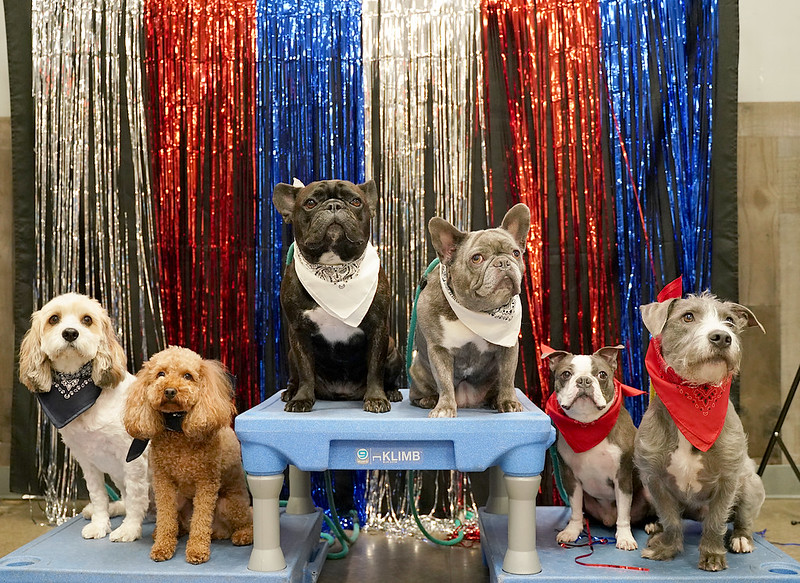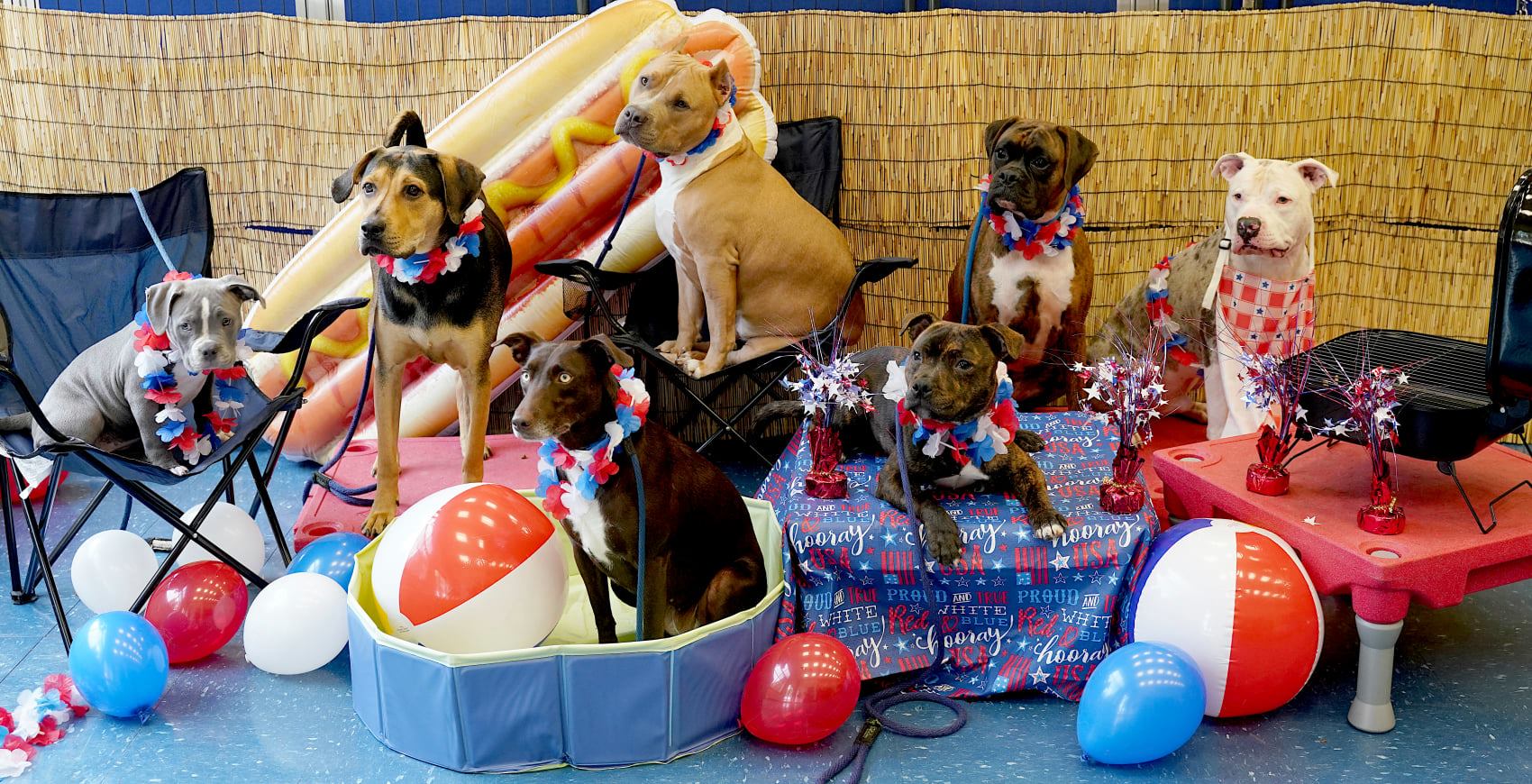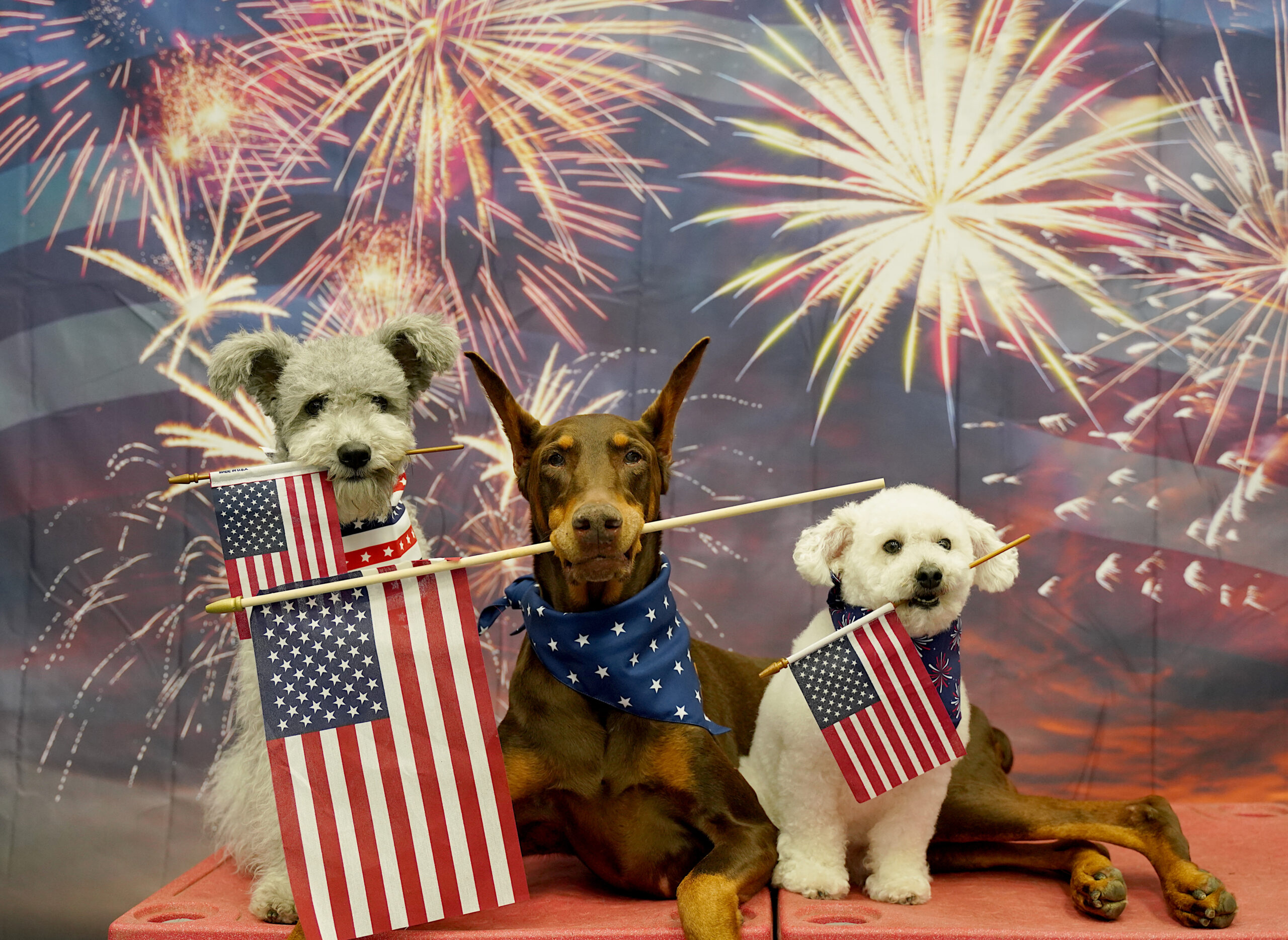
With the 4th of July just around the corner, we thought this would be the perfect time to give you some strategies and management tools for surviving the holiday with our dogs who might not appreciate “the rocket’s red glare, the bombs bursting in air”!
Fear of fireworks, thunderstorm phobia, and gun-shyness often come as a package deal for many dogs — and such dogs might be pretty imperturbable around normal loud noises and activity, but only hit the panic button when the unique booms, cracks and pops of firecrackers or thunder are heard. Other dogs might be easily startled by common noises, but completely unbothered by storms or fireworks. Dogs can also become sensitized to the “crack and boom” category of sounds midway through life after a particularly traumatic or extreme exposure, and develop a pretty persistent phobia from that day onward.
In all situations, the best first option for managing fireworks (or thunderstorms) phobia is prevention — basic obedience training to build a solid trust and communication system between you and your dog, and protecting them from being exposed to unnecessarily loud fireworks without proper preparation.
Young puppies can be gradually exposed to the sound of fireworks and thunder by playing recordings of storms and firework shows at gradually increasing volumes. While it may not completely mimic the actual experience, it can help create enough familiarity so that when they are finally exposed to a more extreme noise level, they have some past experience to help them make sense of it.
Solid obedience training, which gradually increases the dog’s reliability around distractions, particularly building “bombproof” recalls, place/stay and heeling, can also give you the tools to provide meaningful direction to your dog when they might start to show signs of uncertainty or stress in the face of loud noises or scary situations. Oftentimes just having their handler being ready to provide leadership and guidance through the experience is enough to help prevent an initial concern from turning into a deeper fear.
You can also use counter-conditioning with young dogs and puppies by making it “rain treats” when exposed to fireworks at a tolerable level, or playing tug and fetch immediately after hearing a distant pop or bang, so the dog starts to associate the sound with reward, and it can quickly break them out of a more defensive frame of mind. Some hunting dog breeders will also pre-condition puppies against fearing gunfire by regularly putting treats in a paper lunch bag, blowing it up with air, and then “popping” it loudly, causing treats to scatter around the puppies immediately after they might have startled at the loud noise.
So in that sense, preparation for the 4th of July starts the moment you bring your dog home, or at least a few months before Independence Day or New Years Day arrive. But what if you’re past that point? What if your dog already has developed a fear of fireworks/thunder? What should you do to get through the holiday safely?
There are many strategies that might help, and in some cases it will just take some experimentation or a combination of methods to get a result that works for your dog!
First, the standard caveats:
1.) Make sure your dog is wearing a collar with I.D. tags and/or microchipped and the info is up to date, just in case they get loose. Collars should be well fitted, and we strongly recommend using a martingale collar or slip leash during the holiday week so that it’s impossible for your dog to escape the collar.
2.) Do not let your dog outside unattended, even if you have a fenced yard (dogs have panicked when hearing fireworks outside, escaped the yard fencing and then gotten hit by cars). Keep your dog leashed or dragging a long line outside if your fencing isn’t super secure.
3.) Avoid taking your dog with you to firework shows or neighborhood BBQs where firecrackers might be present. You should also avoid leaving them home alone in an area where fireworks or firecrackers in the neighborhood can be loud even when indoors. Again, you want to be supervising and present to help your dog in case they start to have an issue.

If your dog is already sensitive to fireworks and you want to do everything you can to help them through the holiday with minimal stress, the following options can be very helpful:
1.) Calming supplements or prescription sedatives provided by your vet may ease anxiety. Examples include L-Theanine, CBD, Melatonin, Trazadone etc. Be sure to discuss with your vet first, and test them before the big day to see how your dog is affected so you know what to expect. It’s important to give them at least an hour before the dog is exposed to the stressor. Melatonin and L-Theanine can be given daily for longer periods of time, so you also have the option of keeping your dog dosed for the entire holiday week in case of random fireworks, and saving the heavier medications like Trazadone for when the natural supplements aren’t enough.
2.) Thundershirts can be effective for some dogs. If your dog is the type who responds to fireworks by trying to hide, burrow under things, etc then they might be soothed by the compression of a Thundershirt.
3.) On the 4th, give your dog plenty of exercise/training earlier in the day so they are nice and tired (you might consider bringing them to Day Training Daycare the day before for extra activity!) and take them out to potty before the noise typically starts that evening so you do not have to take them outside again until the fireworks quiet down at the end of the night.
4.) During the loudest part of the evening, have lots of white noise on in the home (white noise machines, fans) and keep windows/doors closed. Consider hanging out with your dog in the most interior part of the house to buffer them from the sounds. Often, playing a nice long and LOUD action movie with plenty of explosions/gunfire can help drown out the real fireworks going on outside! (Independence Day, anyone??)
5.) Support and give direction to your dog during this time. Put a leash on them, and have them work Place or the Long Down while you watch a movie. Practice some fun tricks or basic obedience if they need to move around some (keep it positive but insist they work correctly). Do not just let your dog pace around and get worked up when the noise starts! They might be too stressed to take food, and that’s fine. In that situation, the Place Command or Long Down is enough. If they’ll chew a bone or work on a frozen lick mat or stuffed Kong toy, that’s also a great option!
6.) If you must leave your dog crated home alone during the 4th of July but aren’t sure how your dog will react, we would suggest moving the crate to the most interior room in the house (such as a bathroom with no windows). Turn on some white noise at a decent volume (we love this youtube channel) and cover the crate in a thick blanket to buffer sounds, leaving at least some uncovered space at the front of the crate for ventilation. You can also put on the Thundershirt or give the calming supplements/meds that help your dog for added insurance. That should offer the most noise protection to avoid exposing your dog to anything overly loud or traumatic when you aren’t around to reassure them!
Fireworks can be incredibly stressful for some dogs, and anyone who has ever lived with a dog with firework or thunderstorm phobia knows just how terrorized the dogs can be by them. Prevention and preparation is always going to be the best first course of action, but we hope all these tips help you and your pup get through the festivities safely!

